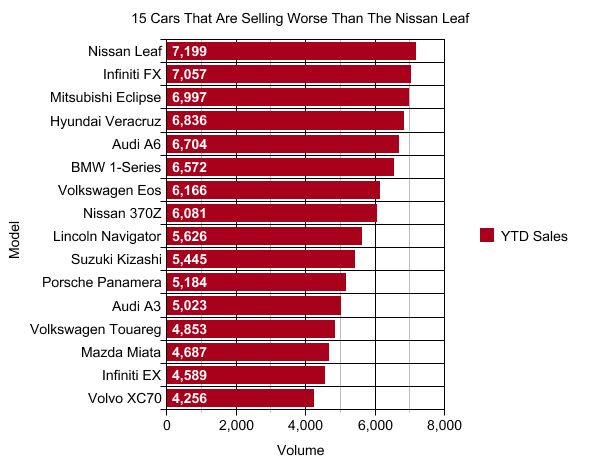The EV Market In Context: 15 Cars That Are Selling Worse Than The Nissan Leaf (And Chevy Volt)
Because electric cars represent the first fundamental technological shift for the automobile since its invention, their appearance on the US market has elicited quite a bit of skepticism. And as with any new technology, the first generation of EVs does have some serious downsides. For example, you can charge a Nissan Leaf at any outlet, but it takes 21 hours. Also, the Leaf’s range that was once promised at 100 miles is typically under 70 miles in the real world. Plus, it’s not exactly cheap. In the face of these challenges, you might think the Leaf, the first mass-market pure-EV in the US, would be forever doomed to a small niche of the market. But small compared to what? To give a real-world taste of how America’s first pure EV is selling in the context of the broader market, here are the year-to-date sales numbers for the Leaf and 15 other vehicles that you might not expect to be selling worse than an electric car. Incidentally, all of these models are also selling better than the market’s other pioneering plug-in, the Chevrolet Volt… which now has its own graph in the gallery below.
More by Edward Niedermeyer
Latest Car Reviews
Read moreLatest Product Reviews
Read moreRecent Comments
- ToolGuy 9 miles a day for 20 years. You didn't drive it, why should I? 😉
- Brian Uchida Laguna Seca, corkscrew, (drying track off in rental car prior to Superbike test session), at speed - turn 9 big Willow Springs racing a motorcycle,- at greater speed (but riding shotgun) - The Carrousel at Sears Point in a 1981 PA9 Osella 2 litre FIA racer with Eddie Lawson at the wheel! (apologies for not being brief!)
- Mister It wasn't helped any by the horrible fuel economy for what it was... something like 22mpg city, iirc.
- Lorenzo I shop for all-season tires that have good wet and dry pavement grip and use them year-round. Nothing works on black ice, and I stopped driving in snow long ago - I'll wait until the streets and highways are plowed, when all-seasons are good enough. After all, I don't live in Canada or deep in the snow zone.
- FormerFF I’m in Atlanta. The summers go on in April and come off in October. I have a Cayman that stays on summer tires year round and gets driven on winter days when the temperature gets above 45 F and it’s dry, which is usually at least once a week.




































Comments
Join the conversation
I think all of those 7200 Leafs (Leaves?) must have been sold in the Seattle area because I see one pretty much daily. It still has a ways to go to match the Prius (which is pretty much Seattle's official car) but they aren't just a curiosity. Never understood why GM didn't offer the Volt here first and instead let Nissan establish a beachhead. It will be interesting to see if the Volt can dent the Leaf's dominance of the electric vehicle market when it goes on sale here.
It's silly to compare Leaf sales to those of any non-electric. Leaf buyers are eligible for $7500 US government incentives. Leaf buyers in CA get additional incentives. Then, on the other hand, is the low production rate, frustrating those who want to buy them. Some people don't buy Leaves because they can't buy them. Other people don't buy them because they still cost too much even after incentives. Those who buy Leaves now probably paid $1000 for a BluRay player when they first dropped. Still others don't buy Leaves because they don't go far enough on a charge. Still others are skeptical of the Leaf's ability to start, run for any distance , provide adequate cabin heat and defrosting capability in cold weather. Things will probably get better on these fronts.